by David Greer
“If mankind were to disappear, the world would regenerate back to the rich state of equilibrium that existed 10,000 years ago. If insects were to vanish, the environment would collapse into chaos.” —E. O. Wilson
“[Rachel] Carson may have won a battle, but not the war.” —Dave Goulson, Silent Earth
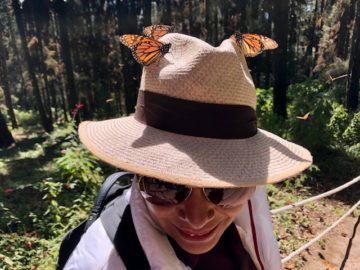
January 31, 2019
Though it’s close to noon high on a mountain about fifty miles west of Mexico City, the oyamel firs alongside the trail in the Monarch Butterfly Biosphere Reserve are covered in shadow, and something else besides. Their branches appear to sag beneath the weight of dark unmoving masses like swarms of bees multiplied many times over, so thick on the trees that the needles of the firs are entirely invisible.
As the winter sun approaches its zenith, its first rays strike the firs and warmth starts to creep into the clearings between the trees. Myriad wings, orange and black, begin to tremble. Soon afterwards, a few random butterflies disengage from the swarms and lift lazily into the air. Within minutes, the sky between the treetops is speckled with butterflies lazily twisting and turning as if stretching from a long night’s sleep. Their numbers quickly swell, the fluttering of wings now loud as the patter of gently falling rain, an incongruous sensation to experience on a trail beneath a cloudless sky.
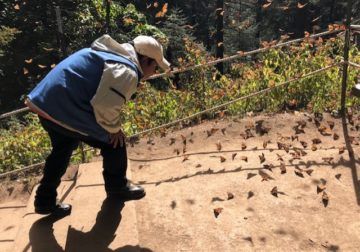
The trees are now bare of butterflies but every other surface seems to be covered—bushes, flowers, hats, shirts, skin, the rope handrail, the path itself. As the number of butterflies littering the path increases, one of the Monarch Butterfly Biosphere Reserve staff materializes to clear them out of the way of tourists so they won’t be trampled. He does so not with a leaf blower but with his mouth, patiently bending and gently blowing as he ascends the trail, rising to let a tourist pass, then repeating his task, bending and blowing until his charges lift themselves and slowly take flight.
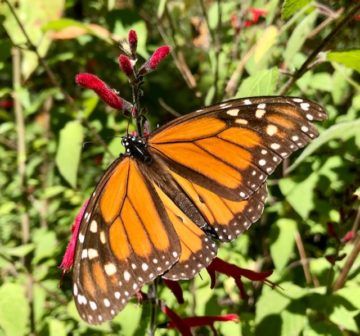
The abundance of butterflies here (all monarchs) is staggering, seemingly beyond belief. In 2008, the UN World Conservation Monitoring Center estimated the number of monarchs returning each fall to this biosphere reserve from their summer habitat in the United States and Canada at up to a billion. The numbers have declined dramatically since then but they’re still mind-boggling.
Three years later. July 21, 2022…
The International Union for the Conservation of Nature (IUCN) adds two migratory populations of the monarch butterfly (Danaus plexippus), the eastern and western North American populations, to its Red List of Threatened species under the Endangered category. Under the IUCN definition, “Endangered” means at very high risk of extinction in the wild.
The IUCN release concludes: “The western population is at greatest risk of extinction, having declined by an estimated 99.9%, from as many as 10 million to 1,914 butterflies between the 1980s and 2021. The larger eastern population also shrunk by 84% from 1996 to 2014. Concern remains as to whether enough butterflies survive to maintain the populations and prevent extinction.”
The IUCN Red List is widely considered the most comprehensive inventory of the global conservation status of biological species. The risk of extinction indicated by an IUCN designation falls into one of seven primary levels:
• Extinct—beyond reasonable doubt that the species no longer exists.
• Extinct in the wild—survives only in captivity, cultivation and/or outside native range.
• Critically endangered—in a particularly and extremely critical state.
• Endangered—very high risk of extinction in the wild.
• Vulnerable—considered to be at high risk of human-caused extinction without further human intervention.
• Near threatened—close to being endangered in the near future.
• Least concern—unlikely to become endangered or extinct in the near future.
Species in the Vulnerable, Endangered and Critically Endangered categories are collectively described as ‘Threatened’.
Assessing the risk to migratory monarch butterflies is a challenging task not least because the life cycle of the butterfly is extraordinarily complex. For example, until relatively recently, no one knew where monarchs summering in eastern North America went in the winter months, and it still remains much of a mystery how millions of butterflies that have never migrated in their lives find their way in a journey of up to 3,000 miles to a precise location in Mexico last visited by their great-grandparents. With that in mind, the following sections loosely describe much of what is known about the life of “the king of butterflies”.
Milkweed and the Great Migration
Milkweed and monarchs have had a troubled relationship from the get-go. The loyalty of monarch butterflies is absolute. They lay their eggs only on milkweed, and their caterpillars eat only milkweed before metamorphosing into butterflies only on milkweed. Monarch butterflies will visit other flowers for their nectar, but without milkweed they cannot breed or survive. Extinguish the milkweed and you extinguish the monarch.
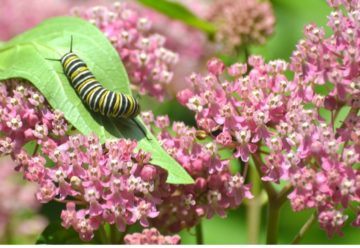
Milkweeds have no such attachment to monarchs. Monarch butterflies don’t even pollinate milkweed flowers on which they land. They’re too big and gangly to meet the milkweed’s needs. In symbiotic relationships, where different species provide useful services to one another, coexistence can proceed smoothly, but milkweeds get nothing from monarchs and for millions of years have been undergoing evolutionary tweaks to discourage the butterflies.
What monarchs get from milkweeds are the cardenolides stored in the milkweed plant’s sticky white latex that exudes from its stems and leaves at the slightest pressure. Milkweed is so toxic that it has killed or harmed countless livestock that haven’t learned to avoid it, but monarch butterflies have adapted and evolved to ingest and store cardenolides so that they become poisonous themselves to larger predators such as birds and smaller ones such as minute parasites. Milkweeds have continually evolved defenses against monarchs (by increasing the toxicity of their cardenolides) and monarchs have successfully adapted to each new defense strategy in what Anurag Agrawal characterizes as “coevolutionary warfare”.
Milkweeds are the reason for the monarch butterfly’s most unusual migration pattern. In September and October, the eastern monarch departs its summer habitat anywhere from Maine to Saskatchewan (or from Newfoundland to Nebraska) and migrates to a small area of oyamel fir forests in the mountains of Mexico’s Michoacán state, flying up to 100 miles a day for up to two months, and spending four to five months clustering on the trees with millions of other monarchs. The round-trip migration has been described as the longest of any butterfly, though it’s likely second to that of the painted lady, whose migration path may take it from close to the Arctic Circle in Scandinavia to northern Africa, with the following year’s return journey carrying it over the Alps.
The southward flight of the monarchs is remarkable not only for its length but also because the butterflies have no past knowledge of their mountain destination yet unerringly find it. They are believed to orient themselves to some extent using magnetic fields, as some migratory birds do (the magnetic charge in the TransVolcanic mountains containing the biosphere reserve shows very high magnetic readings), but how they find their way from several widely separated locations in Canada and the U.S. to tiny wintering grounds is a riddle that remains to be fully solved.
The northward journey in spring is equally astounding for a different reason, namely that it takes two or three generations of monarchs to reach the summer habitat. The reason lies in the monarch’s dependence on milkweed for breeding. Milkweed plants emerge months earlier in the southern U.S. than in the northern part of the country or in Canada, and the monarch northward migration is timed to perfectly match the milkweed’s growing season at different latitudes. After breeding at the overwintering grounds in Mexico, the butterflies migrate north around March to Gulf coast states like southern Texas, where they lay their eggs on young milkweeds and die. The cycle then repeats itself as the next generation of monarchs continues the journey to coincide with the emergence of milkweed as spring progresses to more northern states, where the butterflies born on the Gulf coast breed and die. Thus the monarchs summering in the northern U.S. and southern Canada are two and sometimes three generations removed from the butterflies that migrated south from the same area the previous fall.
Human achievements can seem tiny by comparison, and perhaps that’s a large part of the fascination that monarch butterflies attract. Unfortunately, humans also have a knack for making life hell (and to an increasing extent unlivable) for insects in general and butterflies in particular.
A Rose by any Other Name
Everybody loves the monarch butterfly, but the milkweed that makes the butterfly’s existence possible gets no respect at all. People breed monarch butterflies just so they can release them in large numbers at weddings. Milkweeds they mow down or spray with poison. Where is the justice?
The name of the plant says it all. Anything called a weed isn’t worth the time of day.
People once had high hopes for commercial uses of milkweed. It was transplanted and established in Europe as a possible source of rubber for tires. That didn’t work out so well. Others had the bright idea of stuffing pillows with silk from milkweed pods to induce softness and fluffiness. That also proved a commercial failure. Add to that the fact that domestic animals tended to suffer unpleasant consequences from munching on milkweed, and it’s small wonder that efforts to eradicate the plant faced few objections and that more elegant former names for milkweed such as swan plant and silky swallow-wort fell gave way to more disparaging nomenclature.
Naturally, with the benefit of thousands of years of careful observation and shared wisdom, indigenous peoples found no shortage of practical applications for various parts of the milkweed plant. In North America, these included the crushed leaves (to treat skin ulcers, skin cancers, wounds and headaches), the root (made into a powder or juice to cure tumors and treat wounds, boils and rashes), the sap (to make warts disappear), the seeds (to treat sores), the stem fiber (to make rope), and various parts to treat snakebite. These are only a few of many uses for milkweed by different native peoples.
Ralph Waldo Emerson summed up the reality in a pithy quote: “A weed is a plant whose virtues have not yet been discovered.”
The virtue of being essential to the existence of monarch butterflies seems virtue enough.
The Monarch’s Relatives—Ancestors, Emigrants, Lookalike Cousins
The first ancestor of today’s roughly 170,000 species of moths and butterflies, a creature something like a caddis fly, is thought to have emerged from a watery habitat some 300 million years ago. The evolution of butterflies around 98 million years ago is thought to have been a response to the nectar being produced by new species of flowering plants to attract a more recent arrival than the moths—the bees. The fact that nectar was more abundant by day was a natural incentive for butterflies to leave nighttime to the moths and evolve into a daylight species, which in turn led to the evolution of colorful wings (of no importance to moths, for obvious reasons) to attract mates and, as an added bonus, to warn potential predators to beware of poisons such as the toxic cardenolides that monarchs ingest from milkweed.
Monarch butterflies are native to North and South America but have spread to other places where milkweed grows, including Portugal and Spain, Hawaii, Australia and New Zealand. What makes North American populations unique is their lengthy migrations—except for a population in southern Florida, where the climate favors a lengthy milkweed season, that doesn’t migrate at all. The migratory populations in North America include the western monarchs, which summer in the western U.S. and Canada and migrate to central California in the fall, and the much larger eastern population, which summers in eastern and central Canada and the U.S. and migrates to southern Mexico.
Then there are the butterflies that, while unrelated to monarchs, mimic the appearance of monarchs to fool predators into believing them poisonous. The viceroy in particular has perfected the art of imitation so effectively that it can easily be mistaken for a monarch—as indeed it was by the unfortunate graphic artist tasked with designing a 50-peso banknote issued by the government of Mexico in 2004 to highlight the region of the monarch’s overwintering grounds. The banknote was in circulation for eight years before being corrected to remove the image of a viceroy posing as a monarch.
A Day in the Difficult Life of the Eastern Monarch
Creatures celebrated only for their beauty may lead lives beset by troubles their admirers could never imagine. So it is with the monarch butterfly, and it begins early. Imagine yourself emerging from an egg on a milkweed leaf and understanding instinctively that (a) your primary role as a caterpillar is to eat, and (b) your only source of sustenance is a plant that has spent several million years evolving tricks to discourage you. Your ancestors have evolved jaws to bite into the sticky white latex that permeates the veins of milkweed leaves, but when you tap into your food supply, the latex gushes out like water from a hydrant, smothering you in goo before you have unfolded your metaphorical napkin. The majority of baby monarch caterpillars don’t survive past day one, ignominious victims of sap with attitude.
Next up for the survivors are the parasitoids (typically flies or wasps) that deposit their eggs on or (by injection) inside the caterpillars, which are then slowly eaten from the inside out by the parasitoid larvae, while being kept alive just long enough to allow the larvae to mature and burst through the caterpillar’s epidermis. The rate of attack can be so high that every monarch caterpillar in a particular patch of milkweed plants never makes it to the butterfly stage.
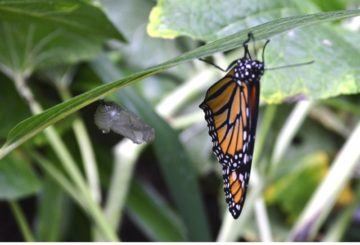
Assuming the caterpillar then successfully constructs a chrysalis from which later emerges a resplendent butterfly, the infant monarch faces a new series of threats. Juvenile birds that have not yet learned that “bright orange wings = poison” opportunistically snap them up before vomiting them out again. If the adult butterfly makes it to late summer without being dispatched by severe storms or speeding cars, it doesn’t get to take a well-earned rest like the average butterfly. The swallowtail, arguably just as pretty as the monarch with its larger wings and sweeping tailcoat, spends its brief life (a week or two at most) finding another swallowtail with which to mate before expiring.
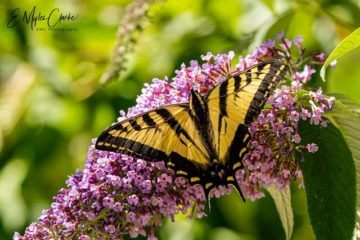
Life is hardly so simple for the monarch. Instead of dating under the harvest moon, it spends late summer flitting among flowers to fatten up for the perilous solo journey to a particular mountain in Mexico without a map or guidance from other monarchs, for they’re all in the same boat—their long-dead great-grandparents were the last ones to see that mountain. Nevertheless, bulked up to perhaps the weight of a small paperclip, off it flutters, flying up to 100 miles a day and at the mercy of whatever storms fate sends its way.
Without a map, the monarch butterfly unerringly finds its way to an oyamel fir forest up to 10,000 feet in altitude, roughly the same elevation as the peak of Washington’s Mount Baker or Alberta’s Mount Rundle. And there it has the luxury of a four-month rest, if it manages to avoid being eaten by the mice and grosbeaks that have evolved strategies for consuming monarchs without being poisoned.
Still the monarch’s work is not complete. Next comes mating, a particularly gruelling experience for the female, given the “pounce and takedown” approach of the monarch male—“nature’s prime example of a male chauvinist pig”, in the words of British naturalist Miriam Rothschild.
The same butterfly that flew south from Illinois or Ontario now takes flight again, this time headed for the U.S. Gulf coast, where milkweeds, restored to life by warm spring temperatures, are once again in bloom, climate change permitting. Finally, her eight-month journey at an end, the female monarch tracks down a milkweed plant, lays her eggs on one of its leaves, and expires. Small wonder that the monarch that flies to Mexico is known as the “Methuselah generation”, so much longer is its life than that of its parents and children.
Death by a Thousand Cuts? Enumerating the Threats
Alarm bells have been ringing for years about the future of the migratory monarch butterfly. Year after year scientists wrestle with how to calculate the decline of a species difficult to count. At the local level, an Ontario farmer who has lived on the same property for several decades told me that today she sees very few monarchs in the same fields where they seemed to fill the sky when she first moved there. It’s a story often repeated. Yet monarch populations demonstrably can also fluctuate hugely from year to year depending on the impact of freezing storms that can wipe out vast numbers, only to be followed by warm and gentle springs that cause populations to rebound. It’s clear, however, that the overall trend is downwards. It’s also clear that declines in monarch populations are almost exclusively linked to human activity. What’s not so clear is the primary cause of the declines and what organizations and individuals can do about it.
After the location of the overwintering grounds in Michoacán state became more than locally known in 1975, the government of Mexico acted relatively quickly to establish a biosphere reserve in 1986 to protect the oyamel forests at the heart of the overwintering grounds from logging. The reserve was expanded to include 217 square miles in 2000. In 2008, Canada, Mexico and the United States cooperated to produce the North American Monarch Conservation Plan with the objective of protecting habitat at the overwintering sites and along breeding and migration corridors.
To compensate for the potential impact on the local economy of creation of the biosphere reserve and to build local support, initiatives were undertaken to involve communities in conservation projects and in benefits from the expected rise in tourism resulting from the biosphere designation. Since then, illegal logging in the off season when the butterflies aren’t present has continued to erode the edges of the reserve. It’s the age-old story: with mouths to feed, strategies for putting food on the table and keeping a roof overhead will always be priority number one. A potential future concern is incursion by avocado farms, already close to the outskirts of the biosphere reserve, which provides ideal climatic conditions for both. Per capita avocado consumption in the U.S. has reportedly more than tripled this century. Capitalizing on the growing popularity in the U.S., Avocadoes from Mexico ran a 30-second commercial during TV coverage of the 2022 Super Bowl. Michoacán state is considered the avocado capital of the world.
For the present, however, the decline in migratory monarch populations is most generally tied to two primary causes: climate change and the impacts of herbicides and pesticides.
Monarch butterflies have evolved to adapt to certain climatic conditions over millions of years but are unlikely to be able adapt quickly to the array of demonstrated and potential impacts associated with climate change now and in the foreseeable future. Alterations in temperature and precipitation patterns in years to come may drastically shrink Michoacán states oyamel fir habitat, the only refuge migrating monarchs have known for millennia. At the other end of the migration, the northern range of milkweed has begun moving steadily further, raising concerns about the ability of the butterflies to adapt to an even longer migration route. (Monarchs have been observed to evolve larger wings as a possible adaptation for that very purpose.) Periodic ruin of butterfly populations by the wilder weather that is the hallmark of climate change can be expected to increase in frequency. The potentially devastating double impact of a winter storm wiping out much of the wintering population, followed by the effect of a harsh, unfavorable summer in the north, is a matter of constant concern to scientists, with the potential to reduce monarch populations to a level that makes recovery improbable or impossible. Finally, some studies show that a warming climate has the potential to further increase the toxicity of native milkweed, posing a potential further threat to the future of monarch populations.
Then there’s the impact of herbicides and pesticides on monarch habitat. Monarch habitat basically has one ingredient: milkweed. Wipe out the milkweed and you wipe out the monarch. Almost all corn and soybean acreage in the U.S. is genetically modified to be herbicide-tolerant—“Roundup Ready” in common parlance. As herbicide use has increased, milkweed abundance has decreased. Suggestions that a genetically modified strain of “Roundup Ready” milkweed that can survive the application of herbicides have not met with industry enthusiasm. Along with herbicides, insecticides such as neonicotinoids have been cited as contributing factors in the decline of monarchs.
The world owes a massive debt for Rachel Carson for being the catalyst for the ban on the use of DDT, triggered by controversy following her 1963 work Silent Spring. Following that success, publication of scientific papers on the use of pesticides slowed to a trickle until the 1990s, after which they increased to a flood, congruent with the arrival of neonicotinoids as the most widely used pesticide in the world, and the subsequent implication of neonicotinoid use in honeybee colony collapse. Dave Goulson laments the fact that conservationists and independent scientists appear to have dropped the ball in assuming Rachel Carson had won. Studies of the impacts of neonicotinoids remain in the early stages, but evidence to date suggests they can have lethal and sublethal effects that may impact butterfly populations at multiple stages. As insecticide use is likely to be correlated with herbicide use, distinguishing the effects of each can be difficult.
There appears to be little clear consensus among scientists on the relative contribution of different factors to the decline of monarch populations. In his book Monarchs and Milkweed, Anurag Agrawal cites research demonstrating that high mortality rates during the migration south to Mexico, after the monarchs have finished feeding on milkweed, are likely to be the primary cause of monarch population declines. Monarch Watch later carried out a study that challenged that conclusion and identified the widespread use of glyphosate (in herbicides such as Roundup) as the main cause of population decline.
Other potential contributors to monarch declines include impacts of non-native milkweeds in disrupting the migration and introducing disease (non-native milkweeds may have been introduced in part by well-meaning monarch lovers buying non-native and typically more toxic milkweeds at nurseries), and an increase in predation of monarchs, including by parasites.
Every now and then someone throws in an additional curveball, like the townhall member who suggested to a panelist that cellphone towers should be investigated for their role in disrupting migrating monarch butterflies directional map by interfering with subtle information of a magnetic nature. It’s easy to dismiss wacko suggestions, except that doing so overlooks science’s long history of wacko suggestions occasionally being proven true, to the embarrassment of the academy.
And so the debate continues.
What is clear is that, whether or not any “primary” cause for the accelerating decline in monarch butterfly populations can be identified, multiple contributing factors are at work, and they have one notable characteristic in common: they are all ultimately the result of human activities, whether intentional, unwitting, careless or simply stupid.
Of course, it’s not just monarch butterflies that have suffered the consequences. Insects in general are believed to have declined in number by roughly 75% in the past 50 years, though most of them lack the charm required to attract attention from anyone other than an entomophile. Similar figures apply for other wild species.
Notably, one particular species has bucked the trend by more than doubling its numbers worldwide during the same time period—the species commonly known as homo sapiens. That might have been considered a good thing a few centuries ago. Now it’s just plain alarming. A metaphor about adding fuel to the fire springs to mind.
What to do? A few ideas:
• Do your homework. Become as informed as you can about the litany of threats to migratory monarch populations. Study issues from several perspectives, recognizing that truth is never black-and-white when it comes to complex environmental issues. Learn what you can from organizations dedicated to the protection of monarch butterfly populations, such as Monarch Watch. Information is power. Obtain and use it wisely, while listening to and respecting other points of view.
• Increase your understanding of the uses of different types of herbicides and pesticides and their impacts on butterfly habitat, then use your knowledge to ask appropriate questions about their use. If you’ve never read Silent Spring, it’s an inspiring reminder of how one person’s passion and informed commitment can change the world. It was published 60 years ago but the central concept is never out of date.
• Do what you can to encourage others to work towards a reduction in greenhouse gas emissions and to reduce your own emissions. Hope springs eternal.
• Plant milkweed, but make sure it’s a species native to the area in which you live, not an import from another country.
References
Agrawal, Anurag. “Advances in Understanding the Long-term Population Decline of Monarch Butterflies.” Proc Natl Acad Sci U S A. 29 Mar 2019
Ibid. Monarchs & Milkweed: A Migrating Butterfly, a Poisonous Plant, and Their Remarkable Story of Coevolution. Princeton, N.J.: Princeton University Press, 2017.
Bowler, Diana E. “Complex Causes of Insect Declines.” Nature Ecology and Evolution 5: October 2021.
Goulson, Dave. Silent Earth: Averting the Insect Apocalypse. New York: HarperCollins, 2021.
Mader, Lindsay Stafford. Milkweed: Medicine of Monarchs and Humans. HerbalGram Issue 101.
Taylor, Orley R. Jr. et al. “Evaluating the Migration Mortality Hypothesis Using Monarch Tagging Data.” Frontiers in Ecology and Evolution, 07 August 2020.
Wade, Nicholas. “How the Butterfly Discovered Daylight,” New York Times, 21 October 2019.
Wilson, Edward O. The Diversity of Life. New York: W.W. Norton, 1992.
